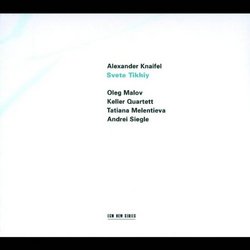| All Artists: Alexander Knaifel, Oleg Malov, Tatiana Melentieva Title: Alexander Knaifel: Svete Tikhiy Members Wishing: 0 Total Copies: 0 Label: Ecm Import Release Date: 4/1/2003 Album Type: Import Genres: Pop, Classical Styles: Vocal Pop, Chamber Music, Historical Periods, Classical (c.1770-1830) Number of Discs: 1 SwapaCD Credits: 1 UPC: 028946181423 |
Search - Alexander Knaifel, Oleg Malov, Tatiana Melentieva :: Alexander Knaifel: Svete Tikhiy
 | Alexander Knaifel, Oleg Malov, Tatiana Melentieva Alexander Knaifel: Svete Tikhiy Genres: Pop, Classical |
Larger Image |
CD Details |
CD ReviewsMusic of great beauty, if a bit overlong Christopher Culver | 09/13/2006 (4 out of 5 stars) "This ECM disc features two works by Russian composer Alexander Knaifel, who like his former Soviet compatriots Gubaidulina and Part has set off on an overtly Orthodox path in his mature career. Knaifel's music is purely in the avant-garde tradition with its innovations of form and conception of silence as an functional part of a piece, but his music features a strong basis on triadic harmony and cathedral-like atmospherics that make the music here accessible for all. The Keller Quartet and pianist Oleg Malov perform on the first piece, while the second features soprano Tatiana Melentieva and technician Andrei Siegle.
"In Air Clean and Unseen" for piano and string quartet (1994) is divided into three movements. The first consists of sparse, pointillistic piano with the tiniest touch of strings, and the second features only strings. One would expect the two to finally meet in some bold way in the last, but no such thing occurs. Instead, the piano again takes the dominant role, and the strings again hide in the background. Knaifel's interest here seems to be pure sound instead of the clever interaction of parts. In the second piece featured here, however, the interaction of voices is the basis of all. "Svete Tikhiy" for soprano and sequencer ("O Gladsome Light", 1991) is a way to realize perfectly a choral work of such complexity that it would hardly be feasible for a live choir. Its first two parts are based on the Orthodox prayer to the Theotokos ("Birth-giver of God", an epithet of the Virgin Mary). In the first, a single soprano voice sings the prayer with wide leaps, while a second soprano voice is altered such that it gives almost an instrumental accompaniment to the first. Only fifty seconds long, it forms a brief prelude to the stunning second movement. Here myriad voices are woven in a bubbling polyphony vaguely like the "Kyrie" from Ligeti's "Requiem" (but profound instead of grim), before all dropping out halfway through to be replaced by a gentle and subtle solo line surrounded by instrumental effects. The last movement is a setting of "O Gladsome Light", the oldest Christian hymn. First mentioned by Justin Martyr circa AD 150, the hymn was already so old that no one remembered who wrote it, and it continues to be sung at every Vespers service. In its liturgical setting, the hymn is usually sung boldly and with joy, but here the solo soprano is quiet, occasionally almost overwhelmed by instrumental effects. All in all, "Svete Tikhiy" is one of the oddest-sounding pieces I've ever heard, but it is still greatly fascinating and entertaining. My only complaint about these works is that they are overlong. I've never been partial to Morton Feldman-like conceptions of length (Knaifel has rivaled the late master with three- or four-hour long pieces). While on the very first hearing the listener is simply dazzled by the crystalline beauty of the piano quintet and the heavenly interaction of parts in the "Svete Tikhiy". Still, for those who like Part or Gubaidulina, Knaifel's music may very well be worth hearing, and it is always enchanting to hear Orthodox composers join the avant-garde tradition to their faith, one always sensitive of beauty." |
